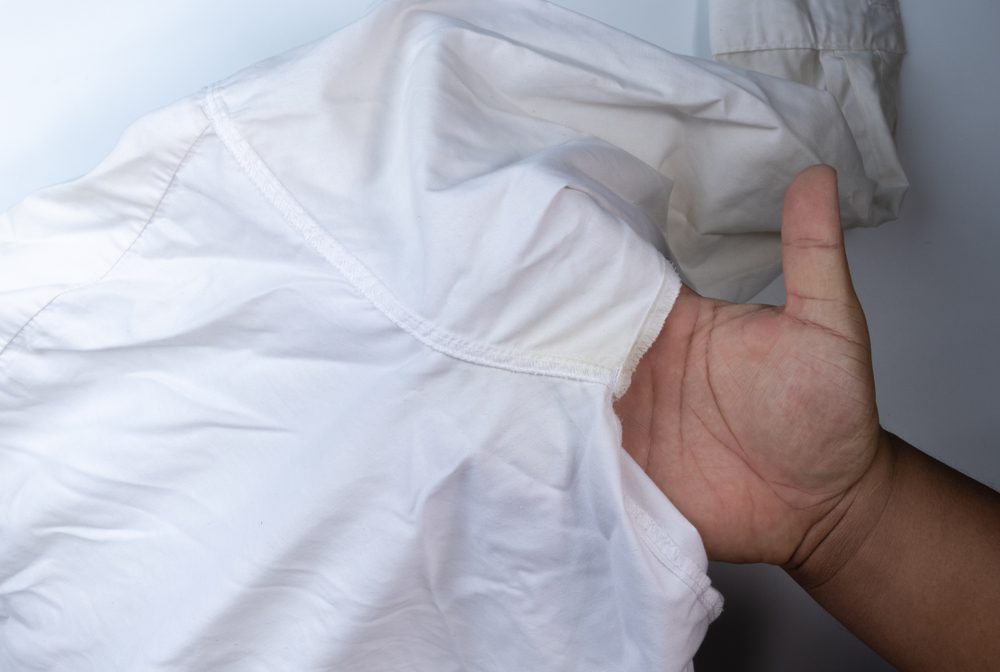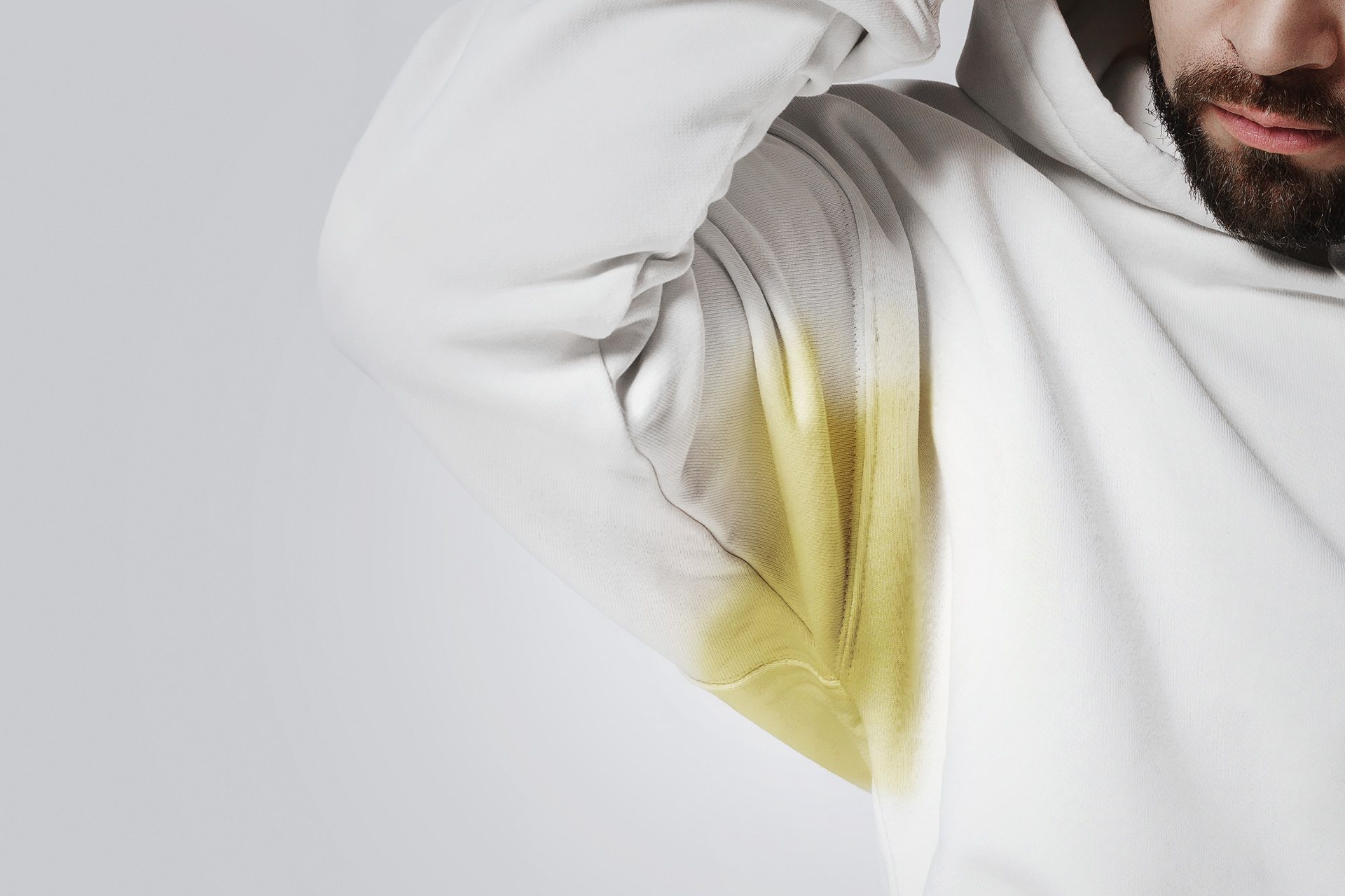It’s definitely embarrassing to notice a yellow sweat stain or chalky deodorant marks on your shirt or office uniform right in the middle of a busy day—whether you’re at work, at a social gathering, or even just running errands. As frustrating as it is, there’s something you can do to remove those stains.
Keep reading this article to learn about the best laundry techniques to remove deodorant and sweat stains once and for all.
Why Deodorant and Sweat Stains Form on Clothes
Understanding what causes those yellow marks and chalky streaks can help you tackle them better. The truth is, a mix of body chemistry, fabric type, and deodorant ingredients all work together to create these stains. Let’s break down the main reasons why they form in the first place.
Aluminum in Deodorants and Antiperspirants
Many deodorants, especially antiperspirants, contain aluminum compounds. While aluminum helps block sweat, it also reacts with the minerals in sweat and creates those yellowish stains, obvious on light-colored fabrics. The aluminum essentially “locks in” the sweat, which bonds with fabric fibers, making stains tough to remove.
Body Oils and Natural Salts
Our bodies naturally produce oils and salts that, when combined with sweat, can easily soak into fabrics. Over time, these natural oils mix with other particles and create a buildup that leads to discoloration, particularly in areas like the underarms of shirts or office uniforms.
Deodorant Residues
Deodorants without antiperspirant properties may not have aluminum, but they can still leave chalky white marks. Ingredients like waxes or thickening agents used to make deodorants stick to your skin are notorious for transferring onto clothing. These residues can layer up, leading to that crusty feeling on fabric if not cleaned properly.
Fabric Choice and Material
Some fabrics, like cotton, are more likely to hold on to sweat and deodorant residue than synthetic blends. The tighter weave of cotton can trap sweat, oils, and deodorant, making these stains more visible and harder to lift. Delicate fabrics like silk or linen may show stains more prominently because they absorb moisture quickly.
High Heat and Laundry Detergent Reactions
Washing your clothes in hot water or using harsh detergents can sometimes set stains rather than remove them. Heat can cause sweat and deodorant residues to stick deeper into the fibers, creating stains that become even more noticeable over time. Plus, certain detergents might not effectively break down the oils and aluminum compounds.
How to Deal with Deodorant and Sweat Stains on Different Fabrics

Removing deodorant and sweat stains can be tricky, especially because not all fabrics respond to the same treatments. The wrong method can make stains worse—or even damage the fabric itself. Let’s look at how to tackle these stains on different materials, so you can confidently care for everything in your closet, from cozy knits to delicate silks.
1. Cotton and Linen
Cotton and linen are breathable and absorbent, making them particularly prone to sweat and deodorant stains. To treat stains on these fabrics:
- Make a paste of baking soda and water, then apply directly to the stain.
- Let the paste sit on the fabric for 30 minutes.
- Rinse out and wash in cold water (avoid hot water to prevent setting the stain).
2. Synthetic Fabrics
Synthetic fabrics, like polyester and nylon, tend to hold on to oils and deodorant residues due to their tighter weave. To treat stains on these fabrics:
- Pretreat with a stain remover or a mixture of dish soap and water.
- Rub the solution gently into the stain and let it sit for 10–15 minutes.
- Wash on a slightly warmer cycle if the fabric can handle it.
3. Delicate Items (Silk, Chiffon, Etc.)
Delicate fabrics require a gentle approach, as aggressive scrubbing or harsh detergents can damage them. For stains on silk or chiffon:
- Use a mild detergent or diluted vinegar solution, applied with a soft cloth or cotton ball.
- Dab (don’t rub) gently to avoid damaging the fabric.
- Rinse with cold water and avoid soaking to prevent watermarks or loss of shape.
4. Leather and Suede
Leather and suede require special care, as moisture can damage their texture. Here’s how to treat deodorant stains on these materials:
- For leather, use a dry cloth to gently wipe the stain, then apply a leather conditioner.
- For suede, use a specialized suede cleaning product or a suede brush to lift any marks.
- When in doubt, consult a professional cleaner for tough stains or extensive damage.
5. Knits and Sweaters
Knits and sweaters are highly absorbent, making deodorant and sweat stains hard to remove if they aren’t addressed quickly. To treat stains on these fabrics:
- Sprinkle baking soda over the stained area and let it sit for an hour to absorb oils.
- Shake off baking soda and hand wash in cold water with a gentle detergent.
- Avoid wringing; gently press water out to maintain the sweater’s shape.
Need a Professional Dry Cleaner Near You in Los Angeles? The Cleaning Club is Just a Phone Call Away!
No need to get frustrated if your washing machine just can’t handle those stubborn deodorant and sweat stains. Whether you’re dealing with challenging fabrics or simply need the convenience of a professional service, The Cleaning Club in Los Angeles, California can certainly help.
For more than 35 years, we have taken pride in offering the best dry cleaning service in West Los Angeles and the surrounding areas. With over three decades of industry expertise, we combine luxury cleaning at an affordable price with a deep commitment to eco-friendly practices. For just $4.50 per garment and a next-day turnaround (after 5 pm, excluding Sundays and holidays), our service is designed to meet the needs of your busy lifestyle.
Services we expertly offer include:
- Dry Cleaning
- Wash and Fold Laundry
- Alterations
- Comforter Cleaning
- Wedding Dress Cleaning and Preservation
Contact The Cleaning Club today for quality care, sustainable cleaning, and service on which you can depend. Call us at 310-836-9700 for more information.
